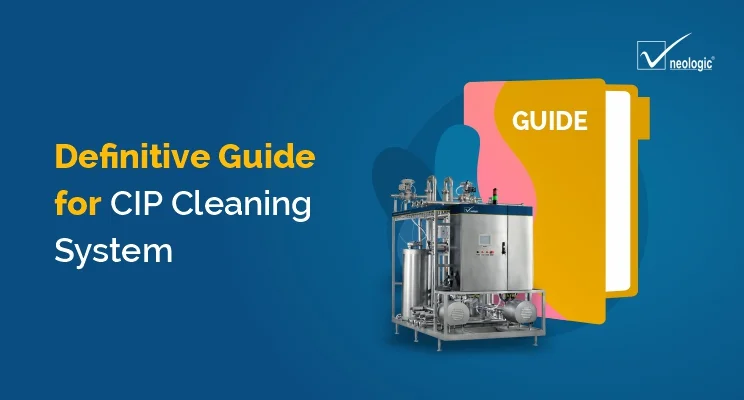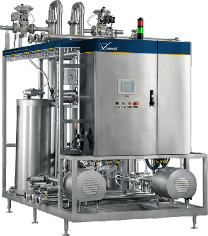
What is CIP Cleaning System?
Manual cleaning of the process plant is very demanding and can cause potential risks to human resources. Also, it can be costly, time-consuming, and can result in ineffective cleaning.
An automated Clean-in-place (CIP) System is a method of cleaning carried out mechanically to remove residues from the whole process plant, fittings, tanks, and piping circuits. This automated process of the Clean-in-place (CIP) System takes place without disassembling or opening the equipment. It’s a cleaning system developed to be quick, efficient, and consistent.
The main purpose of the Clean-in-place (CIP) System is to wash the product contact surfaces to a specified level of cleanliness by passing chemical (detergent and disinfectant) solutions and rinsing water through them. CIP system ensures no direct contact with harmful chemicals or operator entry into confined areas.
How Does the CIP System work?
The CIP system is an effective combination of high solution temperature (thermal energy) and chemical activity of the detergent/chemicals (chemical energy). Along with the mechanical action caused by the turbulent flow and impact of the cleaning solution sprays/jets on the equipment surfaces (mechanical energy).
The CIP cycles are based on the distribution of these energies. The CIP process steps are performed after a processing run that causes normal soiling or when a processing line is transitioned from one product to another.
Usually, there is a 7 step CIP process and it involves steps like,
- Pre-Rinse
- Caustic Wash
- Acid Wash
- Intermediate Wash
- Final Wash
- Sanitizing Rinse
- Air Blow
The Predefined CIP Process Steps of the CIP System are as follows:
Pre-Rinse
This strategic phase of the CIP process steps includes flushing the lines, fittings, and tanks’ internal surfaces. Its objective is to remove the majority of leftover residue i.e., the dissolved sugars and partially melted fats.
The CIP flow channel is of non-chemical pressure test. Potable plant water, de-ionized water, and reverse osmosis water should be used. Or the final rinse water from the last CIP phase can be reused.
Caustic Wash
The purpose of the caustic wash is to soften the fats to help them remove easily.
The caustic wash can be returned to its tank and recovered numerous times. This can save you a lot of water, chemicals, and energy.
Intermediate Wash
This washing cycle wipes off any detergent residue left from the caustic wash. The levels of the wash tank and rinse tank are monitored using level transmitters and probes.
Flow transmitters allow precise management of the wash and rinse processes. Whereas, the conductivity transmitters ensure the chemical levels are in the given range.
Final Wash
Any leftover material or chemical residue is removed with a final rinse of deionized, reverse osmosis, or potable water. Recovering and reusing the final rinse water as the pre-rinse solution for the following cleaning cycle is an economical choice.
Sanitizing Rinse
This final step of the CIP process steps assists in the killing of any microorganisms or pathogens. It ensures food safety and hygiene before beginning the next production batch.
Depending upon the requirements of the cleaning process, these optional CIP process steps can be also employed in the CIP system:
1. Push Out (The Step before Pre-rinse to achieve Increased Product Recovery and Better Cleaning)
2. Acid Wash (To Neutralize the Alkali Effect of Caustic Wash)
3. Air Blow (To Remove any Remaining Moisture)
Components, Fittings, and Accessories Used in CIP Cleaning System Design
For the Clean-in-place (CIP) System – heating cleaning solutions, lye/acid cleaning, sanitization, or rinses with the cleaning fluid in between are the brief operations.
The fundamental components used for the operational design of a CIP system are:
- Tanks
- Centrifugal supply pump
- Suction, return valves & piping
- Waster addition assembly
- Discharge strainer
- Shell & tube heat exchanger
- Instrumentation and automated controls
- Chemical feed equipment
Furthermore, the tank spray cleaning systems can consist of rotary spray heads, jet heads, static spray balls, extension lances, and pumping systems.
The main advantage of the Automated CIP Cleaning System is the increased production time due to less time wasted on labor-intensive cleaning.
Here are the advantages that you can reap from the CIP Cleaning System:
- Advanced Product Safety
- Greater Human Resource Safety
- No Damage due to Disassembly
- Lesser Water Treatment Costs
- Reduced Processing Downtime
- Increased Production Time
- Reduced Environmental Impact
- Record and Traceability of the Cleaning Operations
- Better Product Recovery
- Savings on Utility Costs
- Smaller Maintenance Costs
Features of the Neologic Engineers’ Automated CIP Cleaning System
Being one of the most reputed & globally preferred CIP System Manufacturer, we offer Automated Clean in Place Systems with features like,
- Reliable Components
- Modular Design and Easy Integration with Existing System
- PLC-Based Fully Automated System
- Precise Control of Major Parameters of Temperature, Time, Flow, and Concentration
- Connection Flexibility with Various Automation Systems
- Optimized Consumption of Lye, Acid, Water, and Steam
- 100% Drainability
- Operation Friendly and Independent of Operators’ Skills
Industry Applications of Clean-in-place (CIP) System
Food, Beverage, and CIP Cleaning in the Dairy Industry
Food and Dairy Products come in the highly perishable category. Although packaging and storage conditions protect the food and dairy products from spoilage. If processing conditions allow entry of any microbes or impurities, the product’s shelf life is at stake. For cleaning of the food, beverage processing line and CIP cleaning in the dairy industry, the storage tanks, process equipment, and piping are included. CIP systems for the food industry is done to remove any debris and bacterial build-up on the product contact surfaces from the last processing batch.
Also, having a CIP system for the food industry assists in meeting the FDA Regulations for your food product.
Brewery
Often the breweries are largely automated closed systems, hence utilizing CIP Tank Cleaning System becomes essential. Brewing tanks and vessels are huge in size, hence manual cleaning is not feasible. For breweries, CIP systems have high-capacity spray units for advanced cleaning. In some cases, a phosphoric acid wash may be needed to wash off beer stone accumulation.
Pharmaceuticals and Drug Industry
For CIP System used in Pharmaceutical Industry, the water should be of the highest quality possible. CIP Process helps remove the inorganic, organic, microorganisms, and biological residues from the vessels, reactors, piping, and fittings. The water treatment for CIP in Pharmaceutical Industry goes through three steps viz –Pretreatment, Final Treatment, and Polishing.
The pumps, valves, and fittings used in the CIP system of the Pharmaceutical and Drugs Industry are of the highest efficiency. It is designed to have greater capabilities of cleaning in order to easily clean hard-to-reach and hidden surfaces.
Most Commonly Used CIP Cleaning Chemicals
Caustic
In the CIP Cleaning System, usually, a detergent is used to easily remove the product residue. Caustic soda, sodium hydroxide, or NaOH at a concentration of 0.5 to 2% is used (TEMP-140°F to 150°F) are used. For heavy-duty cleaning of very oily surfaces, the concentrations may go up to 4%. Normally, caustic soda is used as a primary detergent.
Acid
Acid is used for brightening up discolored stainless-steel surfaces. Acid wash stabilizes pH after caustic wash and helps in removing calcified mineral stains. In the dairy industry, these CIP Cleaning Chemicals are frequently used for dairy equipment cleaning to remove milk stone buildups. Nitric acid is most commonly used while Phosphoric acid is used less in comparison.
The acid concentration used for the acid wash is 0.5% at a lesser temperature as compared to caustic wash.
Sanitizers/Disinfectants
These CIP Cleaning Chemicals reduce the risk of food hazards by killing the microbes on the product’s contact surfaces. The commonly used CIP Cleaning Chemicals are various hypochlorite solutions (potassium, sodium, or calcium), generally known as "hypo," as sanitizers. Chlorine (bleach) is the active ingredient in a sanitizing rinse.
It’s a great sanitizing rinse for soils prone to bacterial growth, such as dairy products. Due to its corrosive activity on stainless steel, Peracetic acid (PAA) is used. It is a mixture of hydrogen peroxide and acetic acid and has become a popular alternative to bleach-based sanitizers.
Chlorine dioxide is used as an alternative to hypochlorite solutions in CIP Cleaning System. Especially for surfaces with high organic loads surfaces for meat and fruit processing.
Sterilizers
These CIP Cleaning Chemicals are utilized as a final step to completely remove any remaining microbes. The sterilizers used in the CIP System are used with high-pressure steam. They are employed for ensuring the safety of pharmaceutical products and the long shelf life of food products.
Which Processing Equipment Can Be Cleaned Using CIP Cleaning System?
An automated CIP Cleaning System can be used to efficiently clean areas that are confined and hard to reach. It will save you time and energy and create safe conditions for both the human resources and product.
Clean-in-place (CIP) System can be used to clean internal surfaces of:
- Milk Silos, Storage Tanks, and Process Vessels
- Plate Heat Exchangers (Heaters and Coolers)
- Pasteurizers
- Aging Vats
- Fermenters and Reactors
- Aseptic Tanks
- Sanitary Product Piping, Flow Plates
- Filling Machines
- Road Milk Tankers
Making the Right Choice Among the Types of CIP Systems is a Very Substantial Decision.
Here are some Types of CIP Systems that are used according to the requirements and nature of the processing lines:
- Single Tank (For simple operations with smaller food processing spaces)
- Two Tank or Multi-Tank (Useful for limited water utilities)
- Dual Operating (For simultaneous CIP cleaning with two CIP circuits)
Traditional Cleaning Methods v/s Automated CIP Cleaning System
Cleaning the product contact surfaces of process systems was done manually until the 1950s. The manual cleaning procedures included the dismantling of all piping, vessels, and equipment, and hand-washing all components and surfaces. Then the whole processing setup had to be reassembled before the next production cycle.
Every segment of piping was either hand cleaned or washed in a COP (clean-out-of-place) tank. Likewise, every pump and valve had to be disassembled, cleaned by hand, and reinstalled. To maintain a safe, hygienic process system and minimize product cross-contamination this process had to be repeated. Also, this time and the energy-consuming process didn’t ensure optimal cleaning.
Later, when Clean-In-Place (CIP) solutions progressed, it became a reliable method of cleaning. An automated CIP System that didn’t require the dismantling of processing equipment and pipelines.
A fully programmed and dedicated process with functional tanks, programmable logic controllers, highly accurate sensors, spray devices, heat exchangers, and automatic valves. Product lines were re-engineered to accommodate the functionality of the CIP System.
Adopting a CIP tank cleaning system over manual cleaning might seem like a huge investment. But in reality, CIP Cleaning System has many economic benefits such as,
Better Production:
Less time invested in cleaning activities will allocate more production time.
Increased Customer Satisfaction:
Also, better and safer product quality will result in fewer recalls and customer complaints.
Enhanced Employee Productivity:
With the benefit of the CIP Cleaning System, spending less time on monotonous tasks will be possible. This will help employees concentrate on high-priority and important tasks.
